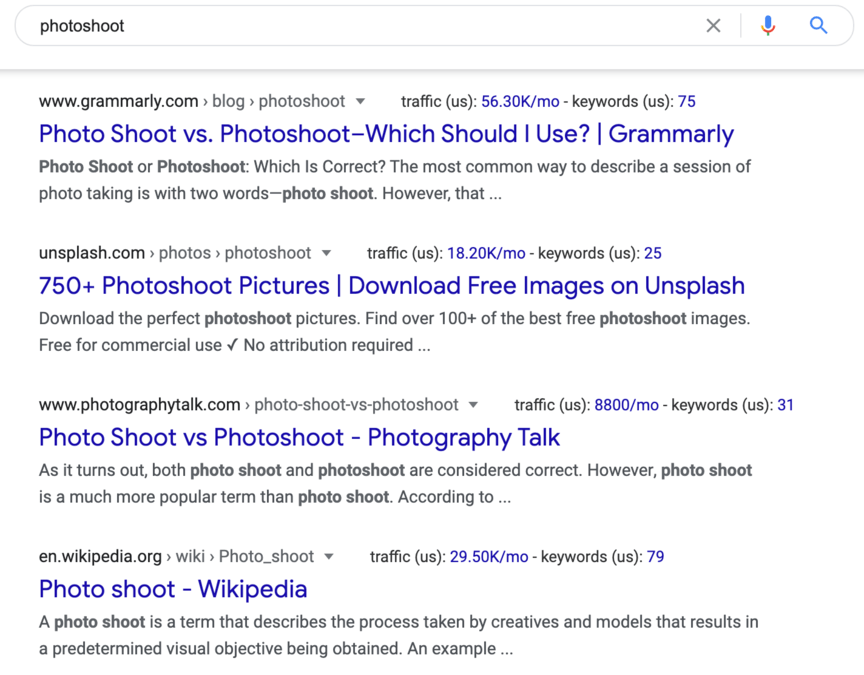-
 Published: Jun 15, 2023
Published: Jun 15, 2023
-
 8 min. read
8 min. read
-
 Macy Storm
Macy Storm Content Marketing Consultant
Content Marketing Consultant
- Macy is a content marketing consultant with over five years of experience creating content for dozens of industries including home services, recreation, and education. She’s written about every marketing topic under the sun, from SEO to AI to email marketing. Her work has been featured by Search Engine Journal, HubSpot, Entrepreneur, Clutch, and more. In her free time, Macy enjoys crafting, reading comic books, and walking her dog Daisy.
Are you wondering how to get more blog traffic to your site? Well you’re in the right place! In this post, we’re exploring 11 tips for driving more traffic to your blog, so let’s dive in!
We foster and form long-term partnerships so that your business has long-term results.
Over 90%
11 tips for how to get blog traffic
To get the best results for your blog, you have to implement numerous optimization tactics both on and off your site. Here are eleven easy things you can do to get more blog traffic:
- Focus on user search intent
- Target long-tail keywords
- Optimize the user experience
- Write evergreen content
- Practice internal linking
- Publish on a consistent schedule
- Earn backlinks
- Promote your blog posts
- Create a positive experience for mobile
- Add related resources
- Create readable content
1. Focus on user search intent
The first thing you should make sure to get right on your blog is addressing user search intent — that is, what users are looking for when they find a particular blog post. This largely revolves around the keywords you target in your blog posts. If you write a blog post to target the keyword “how to replace a doorknob,” make sure your post actually tells users how to replace a doorknob, rather than just advertising the doorknobs you sell. You can gauge the search intent for a given keyword by looking at the pages that are currently ranking the highest for it. Whatever intent they address, you should echo in your own blog post.
2. Target long-tail keywords
The search intent for a given keyword isn’t the only thing you should pay attention to. It also makes a difference what type of keywords you target. In particular, you should look into targeting plenty of long-tail keywords. Long-tail keywords are those that are several words long, and they often yield better results than short-tail ones. For example, it’s probably better to target “professional photoshoot ideas” than to just target “photoshoot.”  The reason long-tail keywords are often the best is that, due to being longer and more specific, they have:
The reason long-tail keywords are often the best is that, due to being longer and more specific, they have:
- Greater relevance to user search intent
- A narrower range of competition
These qualities make them excellent tools for reaching a more relevant audience through Google and improving blog traffic as a result.
3. Optimize the user experience
Another tip for how to improve blog traffic is to optimize the user experience on your website. If users have a negative experience when visiting your blog, it won’t take them long to click away from it, and you want to do what you can to prevent that. One of the first things you should do is ensure that your pages are loading quickly. To help your blog pages load more quickly, you can:
- Cache web pages
- Limit redirects
- Compress images
You can also optimize the reading experience by doing things like:
- Breaking up paragraphs
- Interspersing images
- Using bulleted and numbered lists
These improvements will make for a much easier and more pleasant reading experience for anyone who visits your site, ensuring that they stick around long enough to read your blog posts.
4. Write evergreen content
When you write a blog post, it can be easy to only think in terms of the next day. “What can I include in this post that will be helpful and accurate when users see it tomorrow?” you might ask. But try to expand your perspective not just a few days, but a few years, into the future. Aim to craft posts that are evergreen — that is, avoid including anything that would significantly date your content. Think about writing content that will hold up several years down the road and won’t feel dated. Of course, you can’t always predict what trends will shift and what changes will occur in your industry, so sometimes blog posts will end up feeling dated regardless. When that happens, try to go back and update them to continue driving traffic.
5. Practice internal linking
Another way to increase blog traffic is to use internal links in your content. Internal links are links that lead to other pages on your site — in this case, particularly other blog posts. The benefit of internal links is that they can help lead users to more than one blog post. For example, let’s say you write a blog post on how to set up a computer microphone. Somewhere in that post, you may refer to audio gain and link to a different blog post about that topic. If your readers want to learn more about audio gain, they can follow that link to the other blog post. In doing so, they’re driving up traffic for your blog by reading two posts instead of one.
6. Publish on a consistent schedule
If you want your blog to maintain the traffic it acquires, you need to ensure you publish on a regular schedule. If your posts don’t go out consistently, you’ll find yourself starting to lose even what traffic you had. Posting regularly doesn’t have to mean you publish incredibly frequently. You can put out one post a day or one post a month. Either way is fine, as long as you maintain a consistent schedule. That’s the only way you’ll increase blog traffic. So, if you typically put out one post a week, don’t let two months slip by between two of your posts. Your readers might assume you’ve stopped blogging!
7. Earn backlinks
We’ve discussed internal linking as a way to get more blog traffic, but there’s another kind of link that can benefit your blog — backlinks. Backlinks are where third-party websites in your industry link to your blog posts in their own content. This is beneficial for two reasons. First, Google takes backlinks into account as a ranking factor. When reputable websites link to you, Google sees you as reputable too and ranks you higher. Second, the backlinks expand your potential audience reach to the users on those other sites. To earn backlinks, try looking for broken links on reputable websites in your industry. When you find some, contact the sites to let them know, and recommend they replace the broken links with fresh ones to your blog.
8. Promote your blog posts
To improve blog traffic, utilize the power of email marketing and social media to share your blog posts. Dedicate a section of your regular newsletter to feature new or popular blog content. By reserving a spot in your social media post calendar, you can share blog posts in a fun and friendly manner.
Utilizing these channels can get more traffic to your blog. In addition, when users find your shared content through social media and find them interesting and valuable, they are more likely to share them with their friends and followers, expanding your reach.
9. Create a positive experience for mobile
In the current digital world, more people browse the internet through mobile devices. So I want to emphasize the importance of creating a smooth and positive experience for mobile website visitors.
By optimizing your blog posts for mobile users, you will create a positive experience that will encourage readers to keep revisiting your website and help get you more blog traffic.
10. Add related resources
You and I have done it at some point — when we stumble upon an interesting blog post, we often explore related content and end up clicking on additional resources. Part of our best practice includes adding related blog posts on the sidebar or at the end of each blog post. By doing this, we can keep website visitors staying longer and have the possibility of reading multiple blog posts instead of just one.
11. Create readable content
With a diminishing attention span, you could lose your reader’s interest if you don’t keep them engaged. One effective way to counter this is to make your content readable. You can use our readability test to check your content and see if your blog posts deliver your message in an easy-to-read format for your audience.
By gaining insights from the results, you can identify areas for improvement that will enable you to improve your content and ultimately get more traffic to your blog.
WebFX is a Partner in Driving Results
Hear from HydroWorx, who saw a 131% increase in organic forms by partnering with WebFX
Get more blog traffic with WebFX’s content marketing services
Now that you know how to get traffic to your blog, are you ready to apply that knowledge to your own business blog? If so, WebFX would love to help you! We have over 29 years of experience in digital marketing, so we know all about increasing blog traffic. With our content marketing services, you can get help writing every blog post on your site, as well as optimizing them for Google rankings. You’ll even receive a dedicated account representative to work one-on-one with you throughout the process. To partner with us, just call 888-601-5359 or contact us online today!
-
 Macy is a content marketing consultant with over five years of experience creating content for dozens of industries including home services, recreation, and education. She’s written about every marketing topic under the sun, from SEO to AI to email marketing. Her work has been featured by Search Engine Journal, HubSpot, Entrepreneur, Clutch, and more. In her free time, Macy enjoys crafting, reading comic books, and walking her dog Daisy.
Macy is a content marketing consultant with over five years of experience creating content for dozens of industries including home services, recreation, and education. She’s written about every marketing topic under the sun, from SEO to AI to email marketing. Her work has been featured by Search Engine Journal, HubSpot, Entrepreneur, Clutch, and more. In her free time, Macy enjoys crafting, reading comic books, and walking her dog Daisy. -

WebFX is a full-service marketing agency with 1,100+ client reviews and a 4.9-star rating on Clutch! Find out how our expert team and revenue-accelerating tech can drive results for you! Learn more
Try our free Marketing Calculator
Craft a tailored online marketing strategy! Utilize our free Internet marketing calculator for a custom plan based on your location, reach, timeframe, and budget.
Plan Your Marketing Budget
Table of Contents
- 11 tips for how to get blog traffic
- 1. Focus on user search intent
- 2. Target long-tail keywords
- 3. Optimize the user experience
- 4. Write evergreen content
- 5. Practice internal linking
- 6. Publish on a consistent schedule
- 7. Earn backlinks
- 8. Promote your blog posts
- 9. Create a positive experience for mobile
- 10. Add related resources
- 11. Create readable content
- Get more blog traffic with WebFX’s content marketing services

SEO Success with KOA

Proven Marketing Strategies
Try our free Marketing Calculator
Craft a tailored online marketing strategy! Utilize our free Internet marketing calculator for a custom plan based on your location, reach, timeframe, and budget.
Plan Your Marketing Budget
What to read next






